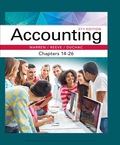
Accounting, Chapters 14-26
27th Edition
ISBN: 9781337514095
Author: Carl Warren, James M. Reeve, Jonathan Duchac
Publisher: Cengage Learning
expand_more
expand_more
format_list_bulleted
Question
Chapter 24, Problem 24.3EX
To determine
Service department charges: These are the indirect expenses incurred by profit center. These are charged for the services received by the department or division, based on the activity base of the service department.
To identify: The activity base of the given service department
Expert Solution & Answer
Trending nowThis is a popular solution!

Students have asked these similar questions
Cooper Industries disposed of an asset at the end of the sixth year of its estimated life for $12,500 cash. The asset's life was originally estimated to be 8 years. The original cost was $76,000 with an estimated residual value of $6,000. The asset was being depreciated using the straight-line method. What was the gain or loss on the disposal? Help
Cooper Industries disposed of an asset at the end of the sixth year of its estimated life for $12,500 cash. The asset's life was originally estimated to be 8 years. The original cost was $76,000 with an estimated residual value of $6,000. The asset was being depreciated using the straight-line method. What was the gain or loss on the disposal?
I need guidance with this general accounting problem using the right accounting principles.
Chapter 24 Solutions
Accounting, Chapters 14-26
Ch. 24 - Differentiate between centralized and...Ch. 24 - Differentiate between a profit center and an...Ch. 24 - Prob. 3DQCh. 24 - What is the major shortcoming of using income from...Ch. 24 - In a decentralized company in which the divisions...Ch. 24 - How does using the return on investment facilitate...Ch. 24 - Why would a firm use a balanced scorecard in...Ch. 24 - What is the objective of transfer pricing?Ch. 24 - When is the negotiated price approach preferred...Ch. 24 - When using the negotiated price approach to...
Ch. 24 - Budgetary performance for cost center Caroline...Ch. 24 - Budgetary performance for cost center Conley...Ch. 24 - Service department charges The centralized...Ch. 24 - Service department charges The centralized...Ch. 24 - Prob. 24.3APECh. 24 - Income from operations for profit center Using the...Ch. 24 - Profit margin, investment turnover, and ROI Cash...Ch. 24 - Profit margin, investment turnover and ROI Briggs...Ch. 24 - Residual income The Consumer Division of Galena...Ch. 24 - Residual income The Commercial Division of Herring...Ch. 24 - Transfer pricing The materials used by the North...Ch. 24 - Transfer pricing The materials used by the...Ch. 24 - Budget performance reports for cost centers...Ch. 24 - Divisional income statements The following data...Ch. 24 - Prob. 24.3EXCh. 24 - Prob. 24.4EXCh. 24 - Service department charges In divisional income...Ch. 24 - Service department charges and activity bases...Ch. 24 - Divisional income statements with service...Ch. 24 - Corrections to service department charges for a...Ch. 24 - Profit center responsibility reporting Glades...Ch. 24 - Return on investment The income from operations...Ch. 24 - Residual income Based on the data in Exercise...Ch. 24 - Determining missing items in return computation...Ch. 24 - Profit margin, investment turnover, and return on...Ch. 24 - Prob. 24.14EXCh. 24 - Determining missing items in return and residual...Ch. 24 - Determining missing items from computations Data...Ch. 24 - Prob. 24.17EXCh. 24 - Balanced scorecard for a service company American...Ch. 24 - Building a balanced scorecard Hit-n-Kun Inc. owns...Ch. 24 - Prob. 24.20EXCh. 24 - Prob. 24.21EXCh. 24 - Budget performance report for a cost center...Ch. 24 - Profit center responsibility reporting for a...Ch. 24 - Divisional income statements and return on...Ch. 24 - Effect of proposals on divisional performance A...Ch. 24 - Divisional performance analysis and evaluation The...Ch. 24 - Prob. 24.6APRCh. 24 - Budget performance report for a cost center The...Ch. 24 - Profit center responsibility reporting for a...Ch. 24 - Divisional income statements and return on...Ch. 24 - Effect of proposals on divisional performance A...Ch. 24 - Divisional performance analysis and evaluation The...Ch. 24 - Prob. 24.6BPRCh. 24 - Prob. 24.1CPCh. 24 - Prob. 24.3CPCh. 24 - Prob. 24.4CPCh. 24 - Evaluating divisional performance The three...Ch. 24 - Evaluating division performance Last Resort...
Knowledge Booster
Similar questions
- A firm has net working capital of $510, net fixed assets of $2,750, sales of $7,200, and current liabilities of $950. How many dollars worth of sales are generated from every $1 in total assets?arrow_forwardHi expert please given correct answer with accounting questionarrow_forwardGeneral accounting questionarrow_forward
arrow_back_ios
SEE MORE QUESTIONS
arrow_forward_ios
Recommended textbooks for you
 Managerial AccountingAccountingISBN:9781337912020Author:Carl Warren, Ph.d. Cma William B. TaylerPublisher:South-Western College Pub
Managerial AccountingAccountingISBN:9781337912020Author:Carl Warren, Ph.d. Cma William B. TaylerPublisher:South-Western College Pub Financial And Managerial AccountingAccountingISBN:9781337902663Author:WARREN, Carl S.Publisher:Cengage Learning,
Financial And Managerial AccountingAccountingISBN:9781337902663Author:WARREN, Carl S.Publisher:Cengage Learning, Survey of Accounting (Accounting I)AccountingISBN:9781305961883Author:Carl WarrenPublisher:Cengage Learning
Survey of Accounting (Accounting I)AccountingISBN:9781305961883Author:Carl WarrenPublisher:Cengage Learning Accounting Information SystemsAccountingISBN:9781337619202Author:Hall, James A.Publisher:Cengage Learning,
Accounting Information SystemsAccountingISBN:9781337619202Author:Hall, James A.Publisher:Cengage Learning, Cornerstones of Cost Management (Cornerstones Ser...AccountingISBN:9781305970663Author:Don R. Hansen, Maryanne M. MowenPublisher:Cengage LearningPrinciples of Accounting Volume 2AccountingISBN:9781947172609Author:OpenStaxPublisher:OpenStax College
Cornerstones of Cost Management (Cornerstones Ser...AccountingISBN:9781305970663Author:Don R. Hansen, Maryanne M. MowenPublisher:Cengage LearningPrinciples of Accounting Volume 2AccountingISBN:9781947172609Author:OpenStaxPublisher:OpenStax College

Managerial Accounting
Accounting
ISBN:9781337912020
Author:Carl Warren, Ph.d. Cma William B. Tayler
Publisher:South-Western College Pub

Financial And Managerial Accounting
Accounting
ISBN:9781337902663
Author:WARREN, Carl S.
Publisher:Cengage Learning,

Survey of Accounting (Accounting I)
Accounting
ISBN:9781305961883
Author:Carl Warren
Publisher:Cengage Learning

Accounting Information Systems
Accounting
ISBN:9781337619202
Author:Hall, James A.
Publisher:Cengage Learning,

Cornerstones of Cost Management (Cornerstones Ser...
Accounting
ISBN:9781305970663
Author:Don R. Hansen, Maryanne M. Mowen
Publisher:Cengage Learning

Principles of Accounting Volume 2
Accounting
ISBN:9781947172609
Author:OpenStax
Publisher:OpenStax College